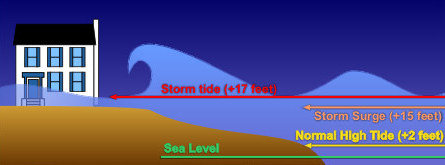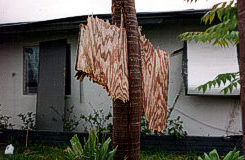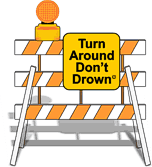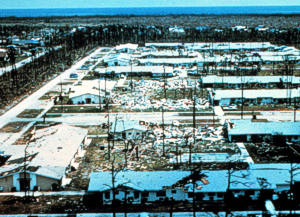Fast Facts
From the Insurance Institute for Business & Home Safety...
Taping windows provides absolutely no protection. It is a myth that taping windows will prevent them from breaking when impacted by windborne debris.
Taping windows to prepare for a storm wastes valuable time which should be instead used to install shutters or plywood. When installed properly, these can provide real protection from high winds and driving rain.
Fast Facts
From the Insurance Institute for Business & Home Safety...
Taping windows provides absolutely no protection. It is a myth that taping windows will prevent them from breaking when impacted by windborne debris.
Taping windows to prepare for a storm wastes valuable time which should be instead used to install shutters or plywood. When installed properly, these can provide real protection from high winds and driving rain.
Each year, beginning around June 1, the Gulf and East Coast states are at great risk for tropical cyclones. While most people know that tropical cyclones can contain damaging wind, many do not realize that they also produce several other hazards, both directly and indirectly. The following is vital information you need to help minimize the impact of tropical cyclones on you and your loved ones. This is your call to action.
Storm Surge
Storm surge is water that is pushed toward the shore by the force of the winds swirling around the storm. The wind can also form large waves on top of the surge. This advancing surge combines with the normal tides to create the hurricane storm tide, which can increase the average water level 15 feet (4.5 m) or more.

This rise in water level can cause severe flooding in coastal areas, particularly when the storm tide coincides with the normal high tides. The destructive power of the storm surge and large battering waves can result in loss of life, destroyed buildings, beach and dune erosion, and road and bridge damage along the coast and can travel several miles inland. In estuaries and bayous, this salt water intrusion endangers public health and the environment.
Because much of the United States' densely populated Atlantic and Gulf Coast coastlines lie less than 10 feet above mean sea level, the danger from storm tides is tremendous.
The level of surge in a particular area is influenced by the slope of the continental shelf. A shallow slope off the coast will allow a greater surge to inundate coastal communities.
Communities with a steeper continental shelf will not see as much surge inundation, although large breaking waves can still present major problems. Meanwhile, storm tides, waves, and currents in confined harbors severely damage ships, marinas, and pleasure boats.
Wind and Squalls
Hurricanes are known for their damaging wind, which is used to rate their strength. However, when the NWS's National Hurricane Center issues a statement concerning the wind and category, that value is for sustained wind only. This hurricane scale does not include gusts or squalls.
Gusts are short but rapid bursts in wind speed and are primarily caused by turbulence over land mixing faster air aloft to the surface. Squalls, on the other hand, are longer periods of increased wind speeds and are generally associated with the bands of thunderstorms which make up the spiral bands around the hurricane.

A tropical cyclone's wind damages and destroys structures two ways. First, many homes are damaged or destroyed when the high wind simply lifts the roof off of the dwellings.
The process involved is called Bernoulli's Principle - the faster the air moves, the lower the air pressure becomes. The high wind moving over the top of the roof creates lower pressure on the exposed side of the roof relative to the attic side. The higher pressure in the attic helps to lift the roof. Once lifted, the roof acts as a sail and is blown clear of the dwelling. With the roof gone, the walls are much easier to be blown down by the hurricane's wind.
The second way the wind destroys buildings can also be a result of the roof becoming airborne. The wind picks up the debris (i.e. wood, metal siding, toys, trash cans, tree branches, etc.) and sends them hurling at high speeds into other structures.
Based on observations made during damage investigations conducted by the Wind Science and Engineering Research Center at Texas Tech University, researchers realized that much of the damage in windstorms is caused by flying debris. In tornadoes, they found that sections of wooden planks are the most typical type of debris observed. A 15-lb 2x4 timber plank in a 250 mph (400 km/h) wind would travel at 100 mph (161 km/h). While 250 mph (400 km/h) is considerably more than even the strongest hurricane's sustained wind, the wind in squalls and tornadoes, could easily reach that speed.
Because of the danger of wind, emergency managers plan on having evacuations complete and personnel sheltered before the onset of tropical storm-force winds, not hurricane-force winds.
Inland Flooding

In addition to the storm surge and high winds, tropical cyclones cause torrential rains and flooding. Even after the wind has diminished, the flooding potential of these storms can remain for several days.
From 2013-2022, 442 deaths have been directly related to tropical systems, and of those 442, 251 (56.8%) were due to inland flooding. Most of these fatalities occur because people underestimate the power of moving water and purposely walk or drive into flooding conditions. Don't do it! You will also underestimate the power of water. Turn Around Don't Drown.
It is common to think that stronger storms have a greater potential for flooding. However, this is not always the case as flooding is related to the motion and track of the storm. As a result, it’s possible for a weaker but slow moving tropical storm to cause more flooding than a more powerful, but fast-moving, hurricane. Two examples are Tropical Storm Allison (2001) and Hurricane Harvey (2017).
Although a tropical storm and not a hurricane, Allison still devastated portions of Southeast Texas with severe flooding due to then-record amounts of rainfall across the area. This is because the storm spent five days over Southeast and East Texas, dumping up to three feet of rain to the east and northeast of Houston during that period.
16 years later in the same region, Harvey made landfall as a hurricane, then rapidly weakened to a tropical storm. Despite the overall decrease in strength, a strong rainband developed west of the Houston metro and produced over 2-3 inches of rain per hour. Heavy rain bands persisted across southeast Texas and eastward for 5 days due to its slow forward speed of around 5 mph as the center of Harvey moved back over the Gulf of Mexico. All of this rainfall combined with the storm surge, causing catastrophic drainage issues, rapid river rises, and widespread flooding that took over two weeks to fall below flood stage, making Harvey the wettest Atlantic storm on record for the U.S.
Tropical cyclones can, and usually do, cause several types of inland flooding.

Flash flooding
Flash floods occur rapidly. This type of flood can begin within a few minutes or hours of excessive rainfall. The rapidly rising water can reach heights of 30 feet (10 m) or more and can roll boulders, rip trees from the ground, and destroy buildings and bridges.
Urban/Area floods
Urban/Area floods are also rapid events, although not quite as severe as a flash flood. Streets can become swift-moving rivers, and basements can become death traps as they fill with water. The primary cause of these floods is the conversion of fields or woodlands to roads and parking lots.
About 10% of the land in the United States is paved roads. Therefore, water that would have been absorbed into the ground now runs into storm drains and sewers that may not be able to handle the capacity of large flood events.
River flooding
River floods are longer term events and occur when the runoff from torrential rains brought on by decaying hurricanes or tropical storms reach the rivers. A lot of the excessive water in river floods may have begun as flash floods. River floods can occur in just a few hours and last a week or longer.
Tornadoes

Tropical cyclones can also produce tornadoes that add to the storm's destructive power. Tornadoes are most likely to occur in the right-front quadrant of the hurricane relative to its motion. However, they are also often found embedded in the rainbands, well away from the center of the tropical cyclones.
Tornadoes are thought responsible for the uneven damage seen in a hurricane's aftermath. The photo (right) shows the total destruction of two buildings in the center of a complex of similar buildings. The added strength of wind combined with the tornado's twisting motion greatly intensifies the destruction.
Some tropical cyclones seem to produce no tornadoes, while others develop multiple ones. Studies have shown that more than half of the landfalling hurricanes produce at least one tornado; Hurricane Buelah (1967) spawned 141 according to one study. In general, tornadoes associated with hurricanes are less intense than those that occur in the Great Plains. Nonetheless, the effects of tornadoes, added to the larger area of hurricane-force winds, can produce substantial damage.
- When associated with hurricanes, tornadoes are not usually accompanied by hail or a lot of lightning.
- Tornadoes can occur for days after landfall when the tropical cyclone remnants maintain an identifiable low-pressure circulation.
- Tornadoes can develop at any time of the day or night during landfall. However, by 12 hours after landfall, tornadoes tend to occur mainly during daytime hours.
A tornado watch is usually issued when a tropical cyclone is about to move onshore. The watch box is generally to the right of the tropical cyclone's path.
Rip Currents
The strong winds of a tropical cyclone can cause dangerous waves. When these waves break along the coast, they can produce deadly rip currents, even at large distances from the storm.
Rip currents are channeled currents of water flowing away from shore, usually extending past the line of breaking waves. They can be strong enough to pull even the strongest swimmers away from shore.
- In 2008, despite the fact that Hurricane Bertha was more than a 1,000 miles offshore, the storm resulted in rip currents that killed three people along the New Jersey coast and required 1,500 lifeguard rescues in Ocean City, Maryland, over a 1 week period.
- In 2009, six people died in the United States as a direct result of tropical cyclones; all six were due to drowning from large waves or strong rip currents.
Learn more about rip currents.
Tropical Cyclone Safety
Tropical cyclones’ widespread impacts, from winds, storm surge, strong currents, and inland flooding, put millions of people at risk. To help people stay safe, NOAA and the National Weather Service (NWS) offer many resources for learning about safety before a storm strikes, from understanding warnings and forecasts, to preparing your home, to taking action when a storm threatens.
Check out NOAA's Hurricane Preparedness site and NWS's Hurricane Safety Tips for information on preparing before a storm, protecting yourself and your loved ones during a storm, and staying safe after a storm has passed. You’ll also find links to other sources of hurricane safety information, like the Center for Disease Control, and additional materials in both English and Spanish to share on social media or anywhere you can make a positive impact.
Fast Facts
From the Insurance Institute for Business & Home Safety...
Taping windows provides absolutely no protection. It is a myth that taping windows will prevent them from breaking when impacted by windborne debris.
Taping windows to prepare for a storm wastes valuable time which should be instead used to install shutters or plywood. When installed properly, these can provide real protection from high winds and driving rain.


